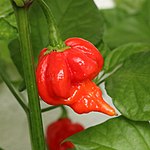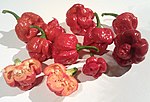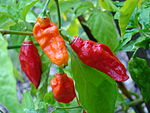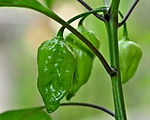Hottest chili pepper

Amongst growers in the US, the UK, Australia, and France, there has been a competition since the 1990s to grow the hottest chili pepper. Chili pepper species and cultivars registering over 1,000,000 Scoville Heat units (SHU) are called "super-hots". Past Guinness World Record holders (in increasing order of hotness) include the ghost pepper, Infinity chili, Trinidad Moruga scorpion, Naga Viper pepper, Trinidad Scorpion Butch T, and Carolina Reaper. The current record holder, declared in 2023, is Pepper X, at more than 2.69 million SHU.[1]
History
Before the early 1990s, there were only two peppers which had been measured above 350,000 SHU, the Scotch bonnet and the habanero.[2] California farmer Frank Garcia used a sport of a habanero to develop a new cultivar, the Red Savina (C. chinense),[3] which was measured at 570,000 in 1994.[2][3] At the time, this was considered representative of an upper limit of chili pepper hotness.[2]

In 2001, Paul Bosland, a researcher at the Chile Pepper Institute at New Mexico State University, visited India to collect specimens of ghost pepper, also called the Bhut Jolokia or Naga king chili,[4] traditionally grown near Assam, India, which was being studied by the Indian army for weaponization.[2][5] When Bosland grew and tested the pepper, he discovered it measured over 1 million SHU.[2] According to Bosland, this "kind of opened the floodgates".[2] In 2006, the Dorset Naga (a subspecies of the Naga Morich) was claimed to be the hottest.[3] In 2012, the Chili Pepper Institute called the Trinidad Moruga scorpion the new hottest pepper, saying it had been measured at 2 million SHU, the first time the 2-million mark had been reached.[3]
Many of the cultivars developed in the attempt to produce ever-hotter peppers are hybrids of chilies traditionally grown in India and Trinidad.[6]
Super-hots
The new peppers have been termed "super-hots".[6] Super-hots are classified as peppers registering over 1 million SHU.[7]
In 2015, Bosland and his team, using fluorescence microscopy, found that super-hots not only have more capsaicin than other peppers, but also store their capsaicin differently. While for most peppers removing the pith and seeds also removes much of the heat, for super-hots this is not true, as they tend to store as much in their flesh as they do in their pith.[7] In their report, Bosland et al. call it a "novel discovery that these 'super-hot' chili peppers have developed accessorial vesicles on the pericarp tissue in addition to the vesicles on the placental tissue, thus leading to exceedingly high Scoville heat units for these plants."[7]
Super-hots should be handled with gloves and using eye protection, as contact with even a single seed can cause skin irritation via chili burn.[3]
Competition and certification
Chili growers compete with one another, often "ruthlessly", to create the world's hottest pepper.[2] According to Marc Fennell, creator of podcast It Burns, the competition is "a hugely controversial war – there are scandals, accusations of cheating, death threats."[8] According to Maxim, the race has "ignited heated debate" among chiliheads and raised "deep questions about science, ethics, and honor."[6][9] Whilst competition mainly takes place among British, Australian, and American growers the competition in the US is noted for its "negativity and fighting."[10]
For many chili growers, the "crowning achievement" is being listed in Guinness World Records.[6] Guinness named a new hottest pepper in 2023, recognizing the Pepper X with 2.69 million Scoville units.[1]
Impact
According to Bosland, the records are "mainly of interest as publicity for purveyors of sauces".[2] As of 2013, hot sauce production and sales were among the fastest growing industries in the US, worth an estimated US$1 billion,[9] and producers "sell more sauce with a world-famous chile on the label".[6] Being able to claim the record can "make or break a new product".[9] The developer of the Naga Viper pepper, which claimed the record for a short period in 2011, earned US$40,000 in one month from sales of seeds and sauces.[11][9] The developer of the Trinidad Moruga scorpion, which claimed the record in 2012, made US$10,000 in two days selling seeds.[9]
Seed sales are also an important revenue stream for developers.[6] As of 2013, super-hot seeds were unavailable from commercial seed suppliers, so those wishing to grow the peppers could obtain them only from the developers or small specialty suppliers.[6] According to Dave DeWitt, in 2013 "a typical Scorpion pepper pod at a farmers’ market [would] go for one dollar", speculating that "behind marijuana, they have the potential to become the second- or third-highest yielding crop per acre monetarily".[6] A bottle of hot sauce claimed to have 16 million SHU sold for US$595.[12] Chiliheads make YouTube videos showing themselves eating super-hots as a means of providing entertainment or marketing the heat of a particular pepper.[6][12]
In Nagaland, India, the annual Hornbill Festival includes a ghost pepper-eating competition.[4]
Hottest peppers
Certified super-hot record holders
Between 2007 and 2012, Guinness "fielded 25 different claims to world's hottest".[9] As of August 23, 2023, Guinness lists Pepper X as the hottest pepper.[1]
| Cultivar | Image | Capsicum species | Developer | Country | Scoville units | Guinness |
|---|---|---|---|---|---|---|
| Pepper X | C. chinense | Ed Currie | US | 2,693,000[1] | 2023 | |
| Carolina Reaper[13] | 
|
C. chinense | Ed Currie | US | 1,641,183[14] | 2017[14] |
| Trinidad Scorpion Butch T[2] | 
|
C. chinense | Butch Taylor[6] Marcel de Wit[2][15] |
US[6] Australia[15] |
1,463,700[9] | 2011[12] |
| Naga Viper[2] | 
|
C. chinense × C. frutescens | Gerald Fowler[2] | UK[3] | 1,382,000[2] | 2011[12] |
| Trinidad Moruga scorpion[2] | 
|
C. chinense | Wahid Ogeer | Trinidad[3] | 1,200,000 | 2012[2] |
| Infinity[2] | 
|
C. chinense | Nick Woods[16] | UK[16] | 1,176,182[16] | 2011[12] |
| Ghost pepper[9] | 
|
C. chinense × C. frutescens[3] | Landrace | India[3] | 1,001,000[9] | 2007[9] |
Uncertified contenders
| Cultivar | Image | Capsicum species | Developer | Country | Alleged SHU | Introduced |
|---|---|---|---|---|---|---|
| Dragon's Breath[17] | C. chinense | Neal Price[17] | UK[17] | 2,400,000[17] | 2017 | |
| Chocolate 7-pot[3] | C. chinense[3] | Landrace | Trinidad[3] | 1,800,000[3] | ||
| Komodo Dragon[18][19] | 
|
C. chinense | Landrace | UK | 1,400,000[18] | 2015 |
| Armageddon[20] | C. chinense × C. frutescens[20] | Landrace | UK | 1,300,000[20] | 2019 | |
| Dorset Naga[3] (subspecies of Naga Morich) |

|
C. chinense[3] | Joy and Michael Michaud[3] | UK[3] | 1,201,000[3] | |
| Naga Morich | 
|
C. chinense[21] | Landrace | India and Bangladesh | 1,000,000[22] |
References
- ^ a b c d Sanj Atwal (16 October 2023). "Pepper X dethrones Carolina Reaper as world's hottest chilli pepper". Guinness World Records Ltd. Retrieved 16 October 2023.
- ^ a b c d e f g h i j k l m n o p Jakab, Spencer (March 26, 2013). "The Arms Race to Grow World's Hottest Pepper Goes Nuclear". Wall Street Journal. ISSN 0099-9660. Archived from the original on May 8, 2019. Retrieved August 14, 2019.
- ^ a b c d e f g h i j k l m n o p q r Hildebrand, Caz (2018). An Anarchy of Chilies. Thames & Hudson. ISBN 978-0-500-02183-5.
- ^ a b Roach, Mary (2013). "The Gut-Wrenching Science Behind the World's Hottest Peppers". Smithsonian. Retrieved August 18, 2019.
- ^ "World's Hottest Chile Pepper Discovered". ScienceDaily. October 28, 2007. Retrieved August 16, 2019.
- ^ a b c d e f g h i j k Anderson, Lessley (April 3, 2013). "Growing Pain: Chilihead fanatics are locked in a race to cultivate the world's hottest pepper". Modern Farmer. Archived from the original on August 27, 2017. Retrieved August 14, 2019.
- ^ a b c Pierre-Louis, Kendra (March 11, 2016). "What Makes the Ghost Pepper So Spicy?". The Atlantic. Retrieved August 15, 2019.
- ^ Pobjie, Ben (April 14, 2019). "Marc Fennell's new podcast It Burns". The Sydney Morning Herald. Archived from the original on May 21, 2019. Retrieved August 14, 2019.
- ^ a b c d e f g h i j Leckart, Steven (December 18, 2017). "In Search Of the World's Spiciest Pepper". Maxim. Archived from the original on April 16, 2019. Retrieved August 14, 2019.
- ^ Hunt, Nicholas (September 17, 2013). "So God Made the World's Hottest Pepper". The Atlantic. Retrieved August 31, 2019.
- ^ Collins, Lauren (October 28, 2013). "The Search for the World's Hottest Chili". New Yorker. ISSN 0028-792X. Retrieved August 31, 2019.
- ^ a b c d e Adams, Paul (July 7, 2011). "FYI: What is the Hottest Pepper in the World?". Popular Science. Archived from the original on December 15, 2017. Retrieved August 14, 2019.
- ^ Winthrop University's attorney, Caroline Craig and their FOIA response, Ed Currie's Testing Results, dated April 21, 2021, shows major deviations from Guinness rules
- ^ a b "Hottest chilli pepper (2017)". Guinness World Records. Archived from the original on January 28, 2023. Retrieved October 16, 2023.
- ^ a b DaSilva, Matthew (April 12, 2011). "World's hottest chilli grown by Aussies". Australian Geographic. Archived from the original on April 15, 2019. Retrieved August 14, 2019.
- ^ a b c Henderson, Neil (December 19, 2011). "'Record-breaking' chilli is hot news". BBC. Archived from the original on May 18, 2019. Retrieved August 14, 2019.
- ^ a b c d "'World's hottest' chilli grown in Wales". BBC. May 17, 2017. Retrieved August 18, 2019.
- ^ a b Smithers, Rebecca (August 11, 2015). "UK's hottest ever commercially grown chilli pepper to go on sale". The Guardian. ISSN 0261-3077. Retrieved August 14, 2019.
- ^ Alexander, Safforn (July 19, 2016). "World's hottest chilli pepper goes on sale at Tesco: are you brave enough to try it?". The Telegraph. Retrieved April 27, 2017.
- ^ a b c "Armageddon arrives: Rocketing pepper demand drives Tesco launch of hottest UK-grown variety". foodingredientsfirst.com. July 30, 2019. Retrieved August 14, 2019.
- ^ Lim, T. K. (2013). Edible Medicinal and Non-Medicinal Plants: Volume 6, Fruits. Springer. p. 205. ISBN 9789400756274.
- ^ "The Scoville Scale". Pepper Information. Chilipepper.com. Archived from the original on 21 July 2012. Retrieved 8 May 2011.[better source needed]

